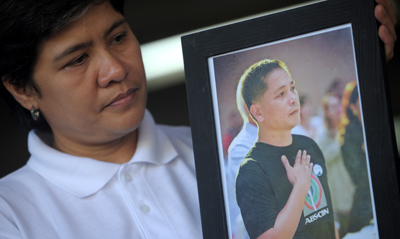We received an unusual email last week. Michaella Ortega wrote to tell us that Marlon Recamata, who confessed to shooting her father, Philippine journalist Gerardo Ortega, in 2011, had been convicted and sentenced to life for the crime.
Emails like this are all too rare. The last time CPJ received news of a conviction in a journalist’s murder was in January, when a court sentenced former police general Aleksei Pukach to a life term on charges of killing Ukrainian journalist Georgy Gongadze in 2000. In 2012, former police lieutenant colonel Dmitry Pavlyuchenkov was convicted of organizing the murder of Russian journalist Anna Politkovskaya, and a Salvadoran court sentenced former gang member Jonathan Alexander Martínez Castro to 30 years for the murder of cameraman Alfredo Antonio Hurtado Núñez. In 2011, the killers of U.S. journalist Chauncey Bailey were sentenced, and two perpetrators imprisoned for the murder of Anastasiya Baburova in Russia. Several suspects were also jailed in connection with two murders in Nepal: the 2009 stabbing of radio journalist Uma Singh and the abduction and murder of Birendra Shah in 2007.
That makes a rate of two to four convictions per year among cases of journalists that CPJ has confirmed were murdered for their work. Compare that fact to this one: An average of 30 journalists are murdered every year, according to CPJ research.
But Recamata’s conviction is only a partial victory–and one that is a reminder of a troubling fact in journalist murders: Those who order the crime are almost never prosecuted.
Recamata, a hired gun, was paid 10,000 Philippine pesos (243 USD), according to a statement issued by the Ortega family. “Cell phones and gadgets cost more than my father’s life,” wrote Michaella Ortega.
In the vast majority of media murders in the Philippines, and often elsewhere, such henchmen do the work of more powerful figures with a motive to silence the victim. Gerardo Ortega sought to expose corruption through his work, like the 190 other journalists targeted for murder since 1992. In particular, he highlighted irregularities in mining contracts awarded by the former governor of Palawan province, Joel Reyes, who, along with his brother Marjo Reyes, the former mayor of a small resort town, was named by Recamata as having ordered Ortega’s assassination. An appellate court blocked an attempt by the Department of Justice to arrest the Reyes’ brothers, who are reported to have since fled the Philippines.
The case is all too similar to the 2005 murder of another well-known Philippine journalist, Marlene Garcia Esperat, who also sought to expose corruption by local officials. Three suspects were convicted in this landmark case, and in the course of the trial, one suspect named regional agriculture department officials Osmeña Montaner and Estrella Sabay as the individuals who ordered him to hire the gunmen. Arrest warrants have been issued against the two officials on multiple occasions but, thus far, all efforts to bring them to trial have been quashed.
In dozens of other cases, masterminds have eluded arrest and investigations have failed to go beyond lower-level suspects. In both the Gongadze and Politkovskaya cases, the political will to pursue the higher-ups behind the killings has been seriously questioned. In Gongadze’s case, President Leonid Kuchma has been implicated as sanctioning the journalist’s murder in retaliation for his reporting on corruption in the government, but evidence behind this accusation has been deemed unusable by courts. It is also not known if Pavlyuchenkov gave information leading to the person who ordered that Politkovskaya be killed, because he was tried behind closed doors as part of a deal with the prosecution.
In Nepal, at least one suspect in the murder of Uma Singh has been out on bail since 2011 with no indication of whether his trial will resume. District police told an international delegation last year, of which I was part, that other suspects, including one of the men believed to have ordered Singh’s attacks, have fled to India.
Last week’s news was indeed a welcome demonstration that it is possible to chip away at the high rate of impunity in the Philippines. Let’s hope the next steps–the apprehension of and a fair and timely trial for the Reyes brothers–aren’t far behind. Masterminds have escaped justice for far too long.
UPDATE: This blog has been corrected to show the correct year of Singh’s murder. Singh was murdered in 2009.
